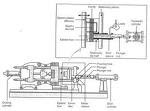In the casting design, factors to consider are:
1. The function of the casting,
2. The ability of the casting,
3. Strength casting,
4. Ease of production,
5. Considerations for safety
6. Economies in production.
In order to meet this requirement, we must have a thorough knowledge of production methods including pattern making, molding, core making, melting and flow, etc.
The best design will be achieved only when one is able to make the right choice from a variety of methods available. However, some rules for designing castings are given below to serve as a guide:
1. Sharp corners and often use the fillet should be avoided to avoid stress concentrations.
2. All parts must be designed in a casting of uniform thickness, as far as possible. If, however, the variation is unavoidable, it should be done gradually.
3. A sudden change from the very thick to very thin sections should always be avoided.
4. Casting should be designed as simple as possible, but with a good appearance.
5. Large flat surface on the casting should be avoided because it is difficult to obtain the correct surface on large castings.
6. In designing the casting, various allowances should be provided in making the pattern.
7. The ability to withstand pressure of casting contraction of some members can be enhanced by providing for example a curved shape, arms, pulleys and wheels.
8. The rigid members such as webs and ribs are used in the casting must be at least possible amount, because it can cause various defects such as hot water and shrinkage, etc.
9. Casting should be designed in such a way that would require a simple pattern and the mold easier.
10. In order to design cores for casting, consideration should be given to provide them adequate support in the mold.
11. Deep and narrow pockets in the casting should always be avoided to reduce cleanup costs.
12. The use of metal inserts in the casting must be kept at a minimum.
13. Signs such as names or numbers, etc., should not be given on vertical surfaces because they provide a barrier in the withdrawal pattern.
14. A tolerance of ± 1.6 mm in the casting of small (under 300 mm) must be provided. In terms of accuracy over the desired dimensions, tolerance ± 0.8 mm can be given.
















